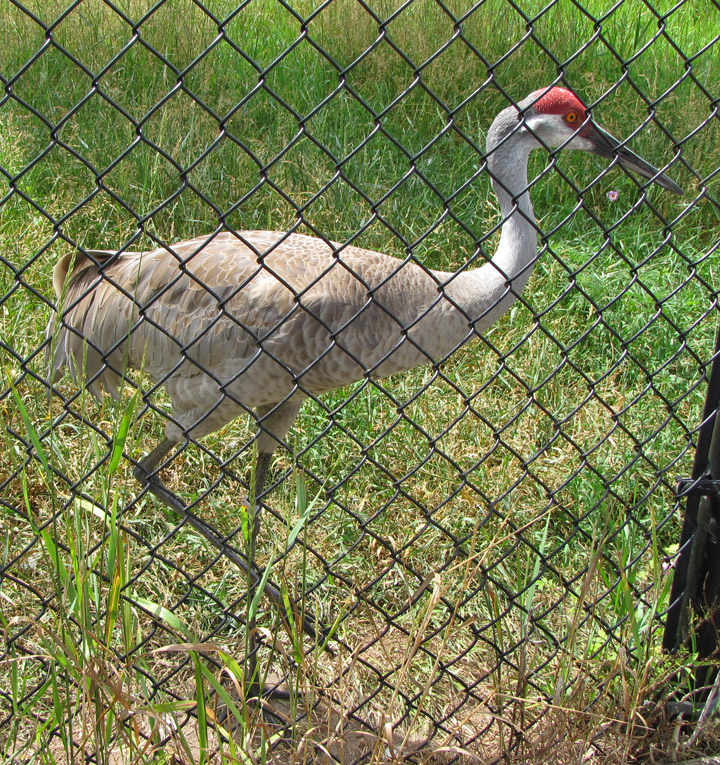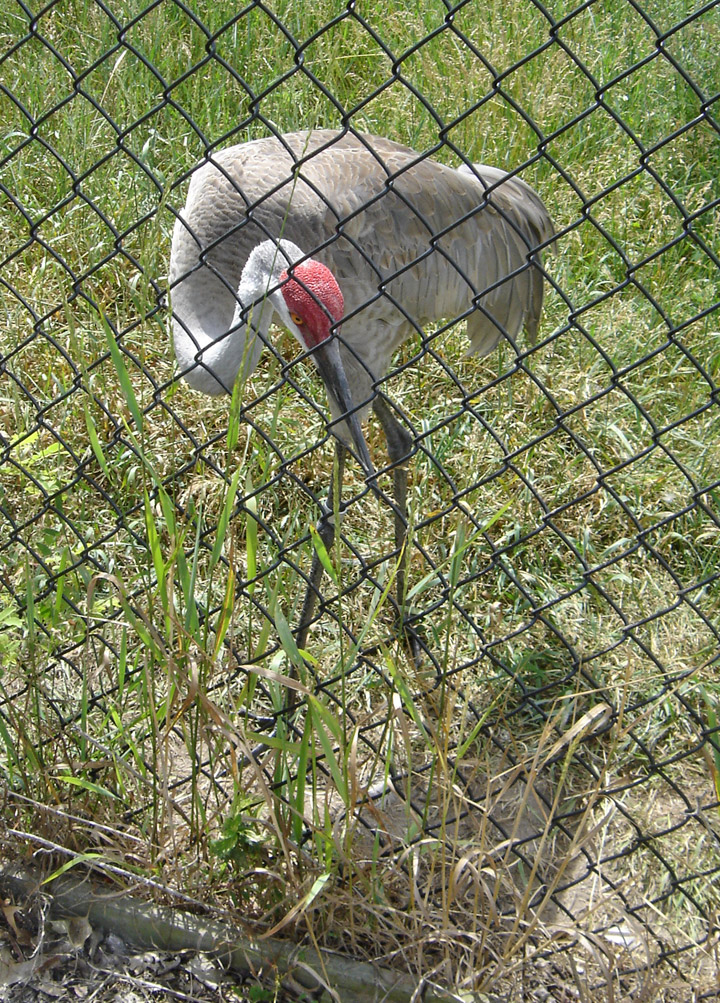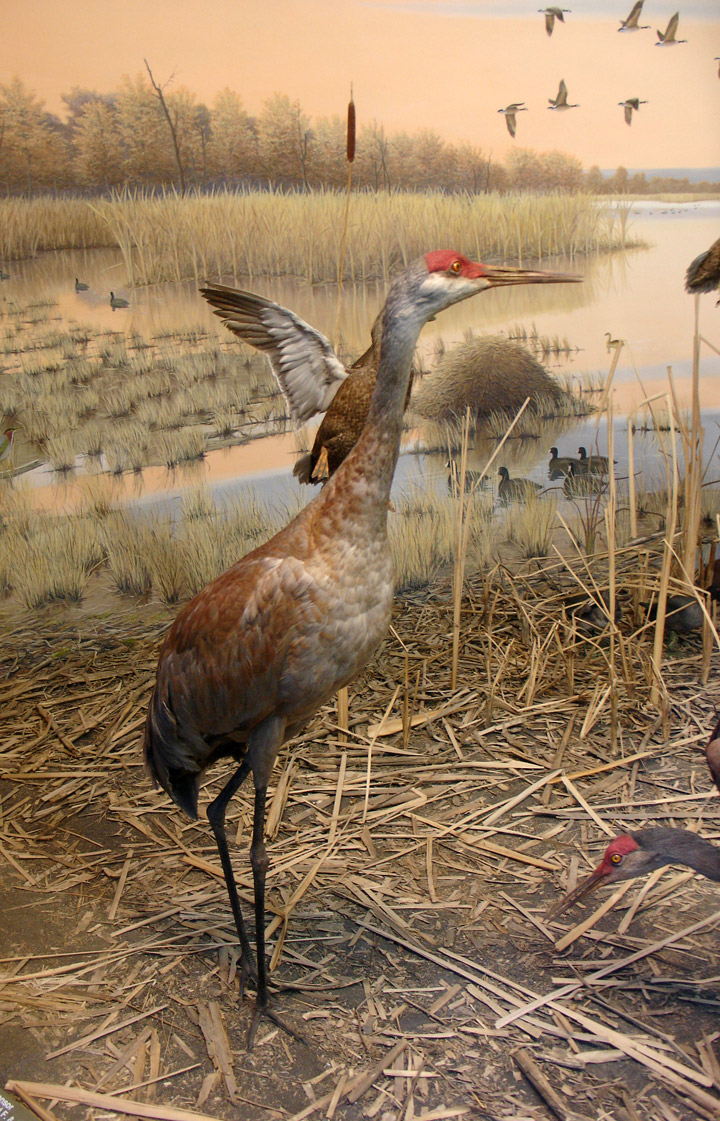

Sandhill Crane

Sandhill Crane
The Sandhill Crane (Grus canadensis)
is a large crane of North America and extreme northeastern Siberia. The common
name of this bird references habitat like that at the Platte River, on the edge
of Nebraska's Sandhills in the American midwest. This is the most important
stopover area for the Lesser Sandhill Crane, Grus (canadensis) canadensis, with
up to 450,000 of these birds migrating through annually.
Adults are gray overall; during breeding, the plumage is usually much worn and
stained, particularly in the migratory populations, and looks nearly ochre. The
sandhill crane has a red forehead, white cheeks and a long dark pointed bill.
Its long dark legs trail behind in flight, and the long neck is kept straight in
flight. Immature birds have reddish brown upperparts and gray underparts. The
sexes look alike. Size varies among the different subspecies. This crane
frequently gives a loud trumpeting call that suggests a French-style "r" rolled
in the throat, and they can be heard from a long distance.

Mated pairs of cranes engage in "unison calling." The cranes stand close
together, calling in a synchronized and complex duet. The female makes two calls
for every single call of the male.

The only other large grayish-bodied bird of North America is the Great Blue
Heron. This heron is of similar dimensions to the Sandhill Crane and is
sometimes mistakenly called a crane, even though it is very different in plumage
details and build. Like other herons, it flies with its neck tucked toward the
body.

The sandhill crane's large wingspan which is 6-8 feet when fully grown makes
this a very skilled soaring bird similar in style to hawks and eagles. Utilizing
thermals to obtain lift, they can stay aloft for many hours, requiring only
occasional flapping of their wings and consequently expending little energy.
With migratory flocks containing hundreds of birds, they can create clear
outlines of the normally invisible rising columns of air (thermals) that they
ride.
Although it is rare, some Sandhill Cranes have been spotted devouring their
young. If the mated pair recognizes a weakness in a young bird, they will eat it

habitat near Amherst, Wisconsin
Though the Sandhill Crane is not considered threatened as a species, the three southernmost subspecies are quite rare. While the migratory birds could at least choose secure breeding habitat, the resident populations could not, and many subpopulations were destroyed by hunting or habitat change. However, initially the Greater Sandhill crane proper suffered most from persecution; by 1940 probably fewer than 1,000 birds remained. They have since increased greatly again, though with nearly 100,000 individuals they are still less plentiful than the Lesser Sandhill Crane, which numbers over 400,000 individuals, making the species the most plentiful crane alive today.

walking with one chick
The Florida Sandhill Crane is far less common, with some 5,000 individuals remaining. They are most threatened by habitat destruction and probably depend on human management in the long run. In Florida, it is protected, and if killed, carries a very high monetary penalty. This subspecies is under protection of state and federal law at this time. Since the loss of habitat is a somewhat controllable cause of a declining population, habitat preservation is a valuable management measure. The current outlook for the Florida sandhill crane, if it can be maintained on the protected habitats, is good. Transplanting wild birds, as well as introducing captive-reared birds into suitable areas where crane numbers are low, appears to be a viable technique in the management of this threatened species. It is hoped that these management strategies, plus continued ecological research, will prevent the Florida sandhill crane from reaching a more critical status.

the Sand Hill crane family
The Mississippi Sandhill Crane has most drastically declined in range; it used to occur along most of the northern Gulf of Mexico coast and its range was at one time nearly parapatric with that of its eastern neighbor (compare the Mottled Duck); today only 25 breeding pairs exist in an intensively managed population, but this seems at least stable in recent times. Some 300 Cuban Sandhill Cranes remain; this is the least-known of the populations.
The Mississippi Sandhill Crane has become the first bird to have a young hatched where an egg was fertilized by a sperm that was previously thawed out from a cryogenic state. This occurred at the Audubon Institute as part of this subspecies' Recovery Plan.

from a diorama in the Milwaukee Public Museum
Sandhill Cranes have been used as foster parents for Whooping Crane eggs and young in reintroduction schemes for that species. This project failed as these foster-raised Whooping Cranes imprinted on their foster parents and later did not recognize other Whooping Cranes as their conspecifics – attempting instead, unsuccessfully, to pair with Sandhill Cranes.
Text from Wikipedia